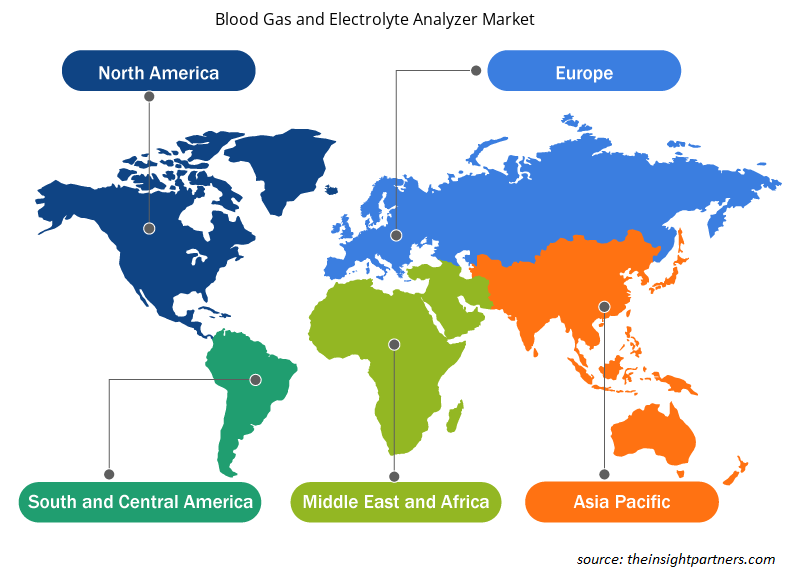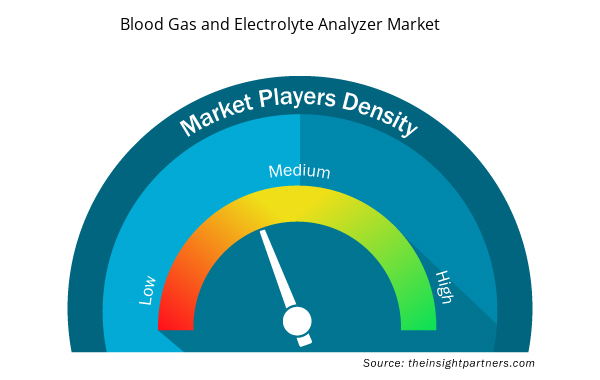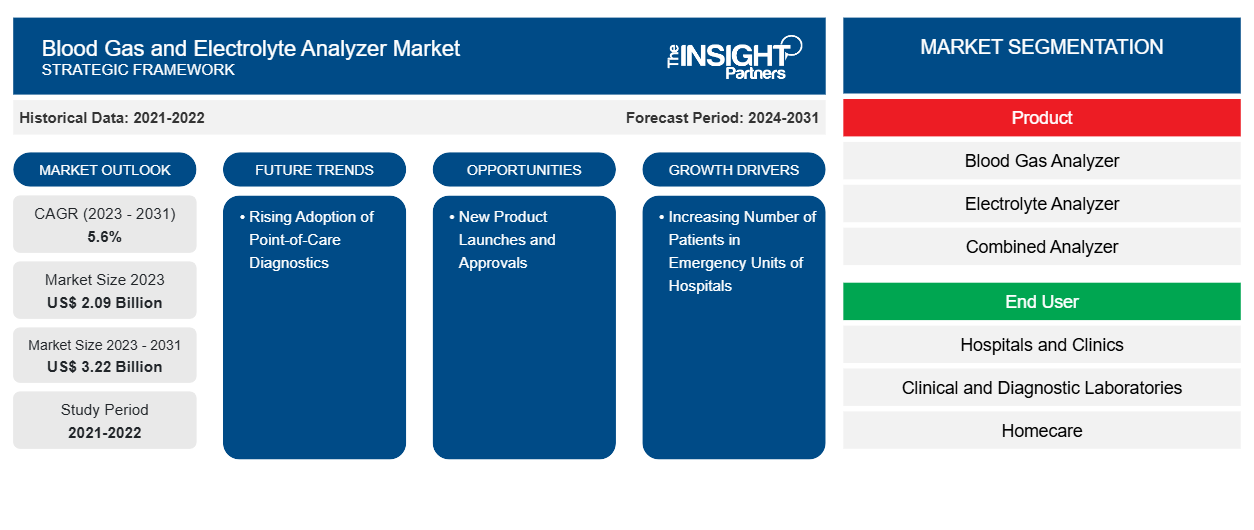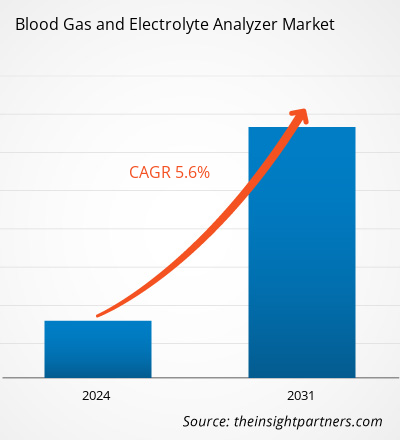血气和电解质分析仪市场规模预计将从 2023 年的 20.9 亿美元增至 2031 年的 32.2 亿美元。预计 2023-2031 年期间市场复合年增长率为 5.6%。血气和电解质分析仪的自动化和人工智能可能仍是市场的主要趋势。
血气电解质分析仪市场分析
血气和电解质分析仪市场增长的主要驱动因素之一是呼吸系统疾病、肾脏疾病和糖尿病等慢性疾病的患病率不断上升。这些疾病通常需要频繁监测电解质平衡和血气水平,以确保适当的管理和治疗。老年人口的增加增加了这些慢性疾病的患病率,从而推动了对血气和电解质分析仪的需求,以支持患者护理并改善临床结果。此外,这些分析仪的技术进步,包括更快的结果、与电子病历的集成以及更高的准确性,推动了血气和电解质分析仪市场的增长。
血气和电解质分析仪市场概况
血气和电解质分析仪的自动化需要使用机器人系统、样品处理机制和自动化工作流程来简化测试流程、减少人工干预并缩短结果周转时间。自动化可提高实验室生产力并最大限度地降低人为错误的风险,确保为医疗保健提供者提供一致可靠的诊断结果。自动化样品处理、智能结果解释和预测分析将使医疗保健提供者能够全面了解患者的代谢状态、电解质平衡和酸碱平衡,从而促进明智的临床决策和个性化治疗策略。此外,集成连接和数字健康解决方案将实现医疗团队之间的无缝数据传输、远程监控和实时协作,从而优化高效的患者护理服务和治疗结果。
定制此报告以满足您的需求
您可以免费定制任何报告,包括本报告的部分内容、国家级分析、Excel 数据包,以及为初创企业和大学提供优惠和折扣
- 获取此报告的关键市场趋势。这个免费样品将包括数据分析,从市场趋势到估计和预测。
血气和电解质分析仪市场驱动因素和机遇
医院急诊科患者数量增加利好市场
在医院急诊科就诊的患者数量不断增加,对血气和电解质分析仪的需求产生了积极影响。根据世界卫生组织 (WHO) 的数据,全球每年约有 1.5 亿患者到医院急诊室就诊。根据美国疾病控制与预防中心 (CDC) 2023 年发布的数据,美国每年约有 1.398 亿人次急诊就诊。此外,2011 年至 2021 年期间,加州的急诊就诊人数增加了 7.4%。随着急诊科面临越来越大的压力,需要对危重患者进行快速准确的评估,及时获得血气值、电解质水平和酸碱平衡的诊断信息变得至关重要。血气和电解质分析仪可提供现场诊断数据,用于评估和管理呼吸窘迫、代谢异常或危重疾病患者。这些分析仪能够实时洞察患者的氧合状态、酸碱平衡和电解质水平,这对于指导复苏措施和优化紧急情况下的临床结果至关重要。随着医院优先加强急救护理服务以满足不断增长的患者数量的需求,血气和电解质分析仪市场正在见证越来越多地采用针对紧急和重症护理环境的技术先进解决方案。
新产品的推出和批准为市场提供了机会
医疗保健行业的发展导致全球医疗保健提供商对血气和电解质分析仪的需求增加。这种需求的增长促进了新产品的开发、产品发布和全球批准。此外,主要市场参与者参与研发活动,以确保高效产品的创新和开发。以下是最近推出和开发的一些产品:
- 2023 年 7 月,西门子医疗推出了用于临床化学和免疫测定测试的新型 Atellica CI 分析仪。美国食品药品监督管理局 (FDA) 在该分析仪首次亮相之前就批准了该分析仪。目前,该分析仪已在多个国家/地区上市。
- 2022 年 7 月,在第 74 届美国临床化学协会年度科学会议和临床实验室博览会 (2022 AACC) 上,EDAN Instruments, Inc. 宣布推出首款基于荧光的即时诊断 (POC) CO-OX 血气和化学分析系统 i20。该系统有超过 45 个参数,包括血气、电解质和 CO-血氧饱和度。
因此,市场参与者之间产品开发、发布和战略合作的增加可能会在未来几年为血气和电解质分析仪市场创造充足的机会。
血气和电解质分析仪市场报告细分分析
有助于血气和电解质分析仪市场分析的关键部分是产品和最终用户。
- 根据产品,血气和电解质分析仪市场分为血气分析仪、电解质分析仪、组合分析仪和其他。组合分析仪部分在 2023 年占据了最大的市场份额。
- 根据最终用户,市场细分为医院和诊所、临床和诊断实验室、家庭护理环境等。临床和诊断实验室部门在 2023 年占据了最大的市场份额。
血气和电解质分析仪市场份额(按地区)分析
血气和电解质分析仪市场报告的地理范围主要分为五个区域:北美、亚太、欧洲、中东和非洲、南美和中美。
2023 年,北美占据了血气和电解质分析仪市场的主导地位。该地区市场的增长得益于公众对心血管疾病的认识不断提高,以及为探索市场创新治疗应用而开展的研究和合作不断增多。随着各种主要参与者的加入,北美血气和电解质分析仪市场预计将蓬勃发展。此外,医疗保健机构采用医疗设备来提高质量和降低成本,也促进了该地区市场的增长。预计亚太地区在预测期内的复合年增长率最高。
血气和电解质分析仪市场区域洞察
Insight Partners 的分析师已详尽解释了预测期内影响血气和电解质分析仪市场的区域趋势和因素。本节还讨论了北美、欧洲、亚太地区、中东和非洲以及南美和中美洲的血气和电解质分析仪市场细分和地理位置。

- 获取血气和电解质分析仪市场的区域特定数据
血气和电解质分析仪市场报告范围
| 报告属性 | 细节 |
|---|---|
| 2023 年的市场规模 | 20.9亿美元 |
| 2031 年市场规模 | 32.2亿美元 |
| 全球复合年增长率(2023 - 2031) | 5.6% |
| 史料 | 2021-2022 |
| 预测期 | 2024-2031 |
| 涵盖的领域 | 按产品
|
| 覆盖地区和国家 | 北美
|
| 市场领导者和主要公司简介 |
|
血气和电解质分析仪市场参与者密度:了解其对业务动态的影响
血气和电解质分析仪市场正在快速增长,这得益于终端用户需求的不断增长,而这些需求又源于消费者偏好的不断变化、技术进步以及对产品优势的认识不断提高等因素。随着需求的增加,企业正在扩大其产品范围,进行创新以满足消费者的需求,并利用新兴趋势,从而进一步推动市场增长。
市场参与者密度是指在特定市场或行业内运营的企业或公司的分布情况。它表明在给定市场空间中,相对于其规模或总市场价值,有多少竞争对手(市场参与者)存在。
在血气和电解质分析仪市场运营的主要公司有:
- 雅培实验室
- Dalko Diagnostics 私人有限公司
- 埃尔巴诊断曼海姆有限公司
- 霍夫曼-罗氏公司
- 美迪卡公司
- Nova 生物医学公司
免责声明:上面列出的公司没有按照任何特定顺序排列。

- 了解血气和电解质分析仪市场顶级关键参与者概况
血气和电解质分析仪市场新闻和最新发展
血气和电解质分析仪市场通过收集一手和二手研究后的定性和定量数据进行评估,其中包括重要的公司出版物、协会数据和数据库。以下列出了市场的一些发展情况:
- Sysmex America, Inc. 获得 FDA 批准,XN-10 自动血液分析仪的血库模式包括残留白细胞计数。该公司透露,新分析仪可以通过在单次样本抽吸中支持残留白细胞计数、红细胞 (RBC) 和血小板 (PLT) 成分检测,提高血液处理中心的效率、一致性和准确性。(来源:Sysmex America,公司网站,2022 年 6 月)
- Sensa Core Medical Instrumentation 推出了 ST-200 CC 血气分析仪 - Ultra Smart,可用于诊所、医院和诊断中心。该公司推出的最先进的血气模型是 ST-200 CC Ultra Smart ABGEM 血气分析仪。它是一种全自动、微处理器控制的电解质系统,使用 ION 选择性电极 (ISE)、阻抗 (Hct) 和电流测定 (pO2) 技术进行电流直接测量,进行动脉血气分析和电解质测量。(来源:Sensa Core Medical Instrumentation,公司网站,2021 年 9 月)
血气和电解质分析仪市场报告覆盖范围和交付成果
“血气和电解质分析仪市场规模和预测(2021-2031)”报告对市场进行了详细的分析,涵盖以下领域:
- 血气和电解质分析仪市场规模以及全球、区域和国家层面所有主要细分市场的预测
- 血气和电解质分析仪市场趋势以及市场动态,如驱动因素、限制因素和关键机会
- 详细的 PEST/波特五力分析和 SWOT 分析
- 血气和电解质分析仪市场分析,涵盖主要市场趋势、全球和区域框架、主要参与者、法规和最新市场发展
- 行业格局和竞争分析,涵盖市场集中度、热图分析、知名参与者以及血气和电解质分析仪市场的最新发展
- 详细的公司简介
- 历史分析(2 年)、基准年、预测(7 年)及复合年增长率
- PEST 和 SWOT 分析
- 市场规模价值/数量 - 全球、区域、国家
- 行业和竞争格局
- Excel 数据集



Report Coverage
Revenue forecast, Company Analysis, Industry landscape, Growth factors, and Trends

Segment Covered
This text is related
to segments covered.

Regional Scope
North America, Europe, Asia Pacific, Middle East & Africa, South & Central America

Country Scope
This text is related
to country scope.
常见问题
Answer: The increasing number of patients in emergency units of hospitals and the rising adoption of point-of-care diagnostics propel the blood gas and electrolyte analyzer market growth. However, the high costs of analyzers hamper the market growth. Automation and artificial intelligence in blood gas and electrolyte analyzers would bring new blood gas and electrolyte analyzer market trends in the coming years.
Answer: Blood gas analyzers are used to measure combinations of pH, blood gas (i.e. pCO2 and pO2), electrolytes, and metabolite parameters from whole blood samples. Blood conservation is an important initiative in every clinical diagnostic lab or critical care facility. Therefore, a highly accurate blood gas analyzer can streamline work processes and reduce errors with minimum maintenance. Most blood gas analyzers offer automatic sample mixing and easy sample aspiration with intuitive user interface built-in and automatic QC for accuracy and regulatory compliance.
Answer: - Based on product, the blood gas and electrolyte analyzer market is divided into blood gas analyzer, electrolyte analyzer, combined analyzer, and others. The combined analyzer segment held the largest market share in 2023.
By end user, the market is segmented into hospitals and clinics, clinical and diagnostics laboratories, homecare settings, and others. The clinical and diagnostic laboratories segment held the largest share of the market in 2023.
Answer: - The blood gas and electrolyte analyzers market majorly consists of the players such as Abbott Laboratories, Dalko Diagnostics Pvt Ltd, Erba Diagnostic Mannheim GmbH, F.Hoffmann-La Roche Ltd, Medica Corporation, Nova Biomedical Corporation, Siemens Healthineers AG, Werfen SA, Radiometer Medical ApS, and Sensa Core Medical Instrumentation Pvt Ltd.
Trends and growth analysis reports related to Life Sciences : READ MORE..
The List of Companies - Blood Gas and Electrolyte Analyzer Market
- Abbott Laboratories
- Dalko Diagnostics Pvt Ltd
- Erba Diagnostic Mannheim GmbH
- F.Hoffmann-La Roche Ltd
- Medica Corporation
- Nova Biomedical Corporation
- Siemens Healthineers AG
- Werfen SA
- Radiometer Medical ApS
- Sensa Core Medical Instrumentation Pvt Ltd
The Insight Partners performs research in 4 major stages: Data Collection & Secondary Research, Primary Research, Data Analysis and Data Triangulation & Final Review.
- Data Collection and Secondary Research:
As a market research and consulting firm operating from a decade, we have published and advised several client across the globe. First step for any study will start with an assessment of currently available data and insights from existing reports. Further, historical and current market information is collected from Investor Presentations, Annual Reports, SEC Filings, etc., and other information related to company’s performance and market positioning are gathered from Paid Databases (Factiva, Hoovers, and Reuters) and various other publications available in public domain.
Several associations trade associates, technical forums, institutes, societies and organization are accessed to gain technical as well as market related insights through their publications such as research papers, blogs and press releases related to the studies are referred to get cues about the market. Further, white papers, journals, magazines, and other news articles published in last 3 years are scrutinized and analyzed to understand the current market trends.
- Primary Research:
The primarily interview analysis comprise of data obtained from industry participants interview and answers to survey questions gathered by in-house primary team.
For primary research, interviews are conducted with industry experts/CEOs/Marketing Managers/VPs/Subject Matter Experts from both demand and supply side to get a 360-degree view of the market. The primary team conducts several interviews based on the complexity of the markets to understand the various market trends and dynamics which makes research more credible and precise.
A typical research interview fulfils the following functions:
- Provides first-hand information on the market size, market trends, growth trends, competitive landscape, and outlook
- Validates and strengthens in-house secondary research findings
- Develops the analysis team’s expertise and market understanding
Primary research involves email interactions and telephone interviews for each market, category, segment, and sub-segment across geographies. The participants who typically take part in such a process include, but are not limited to:
- Industry participants: VPs, business development managers, market intelligence managers and national sales managers
- Outside experts: Valuation experts, research analysts and key opinion leaders specializing in the electronics and semiconductor industry.
Below is the breakup of our primary respondents by company, designation, and region:

Once we receive the confirmation from primary research sources or primary respondents, we finalize the base year market estimation and forecast the data as per the macroeconomic and microeconomic factors assessed during data collection.
- Data Analysis:
Once data is validated through both secondary as well as primary respondents, we finalize the market estimations by hypothesis formulation and factor analysis at regional and country level.
- Macro-Economic Factor Analysis:
We analyse macroeconomic indicators such the gross domestic product (GDP), increase in the demand for goods and services across industries, technological advancement, regional economic growth, governmental policies, the influence of COVID-19, PEST analysis, and other aspects. This analysis aids in setting benchmarks for various nations/regions and approximating market splits. Additionally, the general trend of the aforementioned components aid in determining the market's development possibilities.
- Country Level Data:
Various factors that are especially aligned to the country are taken into account to determine the market size for a certain area and country, including the presence of vendors, such as headquarters and offices, the country's GDP, demand patterns, and industry growth. To comprehend the market dynamics for the nation, a number of growth variables, inhibitors, application areas, and current market trends are researched. The aforementioned elements aid in determining the country's overall market's growth potential.
- Company Profile:
The “Table of Contents” is formulated by listing and analyzing more than 25 - 30 companies operating in the market ecosystem across geographies. However, we profile only 10 companies as a standard practice in our syndicate reports. These 10 companies comprise leading, emerging, and regional players. Nonetheless, our analysis is not restricted to the 10 listed companies, we also analyze other companies present in the market to develop a holistic view and understand the prevailing trends. The “Company Profiles” section in the report covers key facts, business description, products & services, financial information, SWOT analysis, and key developments. The financial information presented is extracted from the annual reports and official documents of the publicly listed companies. Upon collecting the information for the sections of respective companies, we verify them via various primary sources and then compile the data in respective company profiles. The company level information helps us in deriving the base number as well as in forecasting the market size.
- Developing Base Number:
Aggregation of sales statistics (2020-2022) and macro-economic factor, and other secondary and primary research insights are utilized to arrive at base number and related market shares for 2022. The data gaps are identified in this step and relevant market data is analyzed, collected from paid primary interviews or databases. On finalizing the base year market size, forecasts are developed on the basis of macro-economic, industry and market growth factors and company level analysis.
- Data Triangulation and Final Review:
The market findings and base year market size calculations are validated from supply as well as demand side. Demand side validations are based on macro-economic factor analysis and benchmarks for respective regions and countries. In case of supply side validations, revenues of major companies are estimated (in case not available) based on industry benchmark, approximate number of employees, product portfolio, and primary interviews revenues are gathered. Further revenue from target product/service segment is assessed to avoid overshooting of market statistics. In case of heavy deviations between supply and demand side values, all thes steps are repeated to achieve synchronization.
We follow an iterative model, wherein we share our research findings with Subject Matter Experts (SME’s) and Key Opinion Leaders (KOLs) until consensus view of the market is not formulated – this model negates any drastic deviation in the opinions of experts. Only validated and universally acceptable research findings are quoted in our reports.
We have important check points that we use to validate our research findings – which we call – data triangulation, where we validate the information, we generate from secondary sources with primary interviews and then we re-validate with our internal data bases and Subject matter experts. This comprehensive model enables us to deliver high quality, reliable data in shortest possible time.


 获取此报告的免费样本
获取此报告的免费样本